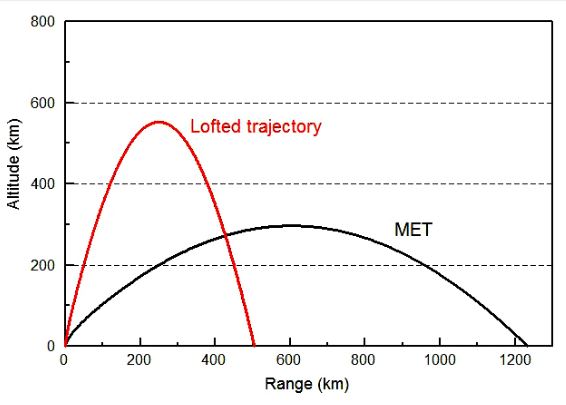Updated 8 pm EST Sunday
North Korea reportedly launched a medium-range missile Sunday morning local time (about 6 pm Saturday on the US east coast).
People are speculating about what missile it could have been. Based on the range, there are at least two candidates, which would be distinguishable by US intelligence if it was able to observe the launch.

Fig. 1
The missile was apparently launched eastward from the Panghyon air base near Kusong, northwest of Pyongyang and traveled 500 km, splashing down in the Sea of Japan. According to the South Korean military, it flew on a lofted trajectory, reaching an apogee of about 550 km.
A missile flown on this trajectory would have a range of 1,200-1,250 km if flown on a standard trajectory with the same payload (Fig. 1).
Nodong or KN-11?
That range is similar to that of the North Korean Nodong missile, which was first tested in the early 1990s and has been launched repeatedly since then. Another launch of the Nodong would not be particularly useful for advancing Pyongyang’s missile program, so if that was what was launched it would have had a political motivation.
However, as Jeffrey Lewis points out, the trajectory is very similar to the trajectory the submarine-launched KN-11 missile flew in its first successful test last August. While similar in range to the Nodong, the KN-11 has the advantage that it uses solid rather than liquid fuel, which means it would take less preparation time before a launch. The North is likely to be interested in developing and testing a land-based version of the missile.
If this is what was launched, it would represent a useful developmental step for North Korea, no matter what may have driven the timing of the launch.
The KN-11 would have a clear fingerprint that would distinguish it from the Nodong (or the Musudan, see below), since it has two stages rather than one, and that difference would be clear if US, Japanese, etc., sensors were able to observe the test.
Other options?
Some of the reports have speculated the test was of a Musudan missile, but I haven’t seen anything about the test that supports that. The Musudan range is considerably longer. The one successful Musudan launch, which took place last June, suggested a maximum range of about 3,000 km, although a recent analysis suggest that the range is probably less than 2,500 km if it carries a payload similar to the mass of a nuclear warhead. (Note that repeated claims that the Musudan can reach up to 4,000 km are not credible.)
It’s also worth noting that North Korea apparently fired several extended-range Scud missiles last September, which have a similar but somewhat shorter range than seen in the test, depending on the payload. These are also single stage and could be distinguished from a KN-11 test.
Of course, the North may surprise us with something else entirely.
Update:
The North Korean news service KCNA has now announced that the launch was in fact of land-based version of the KN-11, which it calls the Pukguksong-2. As noted above, this missile would have a maximum range of about 1,200 km if flown with the same payload as in the test. Having a mobile, solid-fueled missile of this range, which can reach most of Japan, is an important development for the North.
